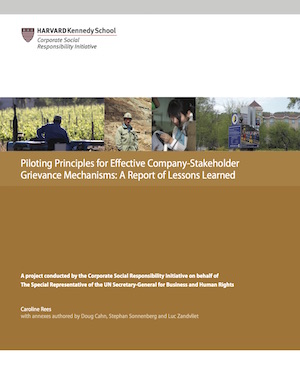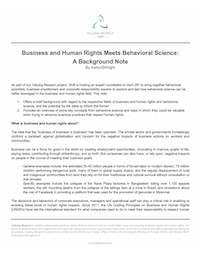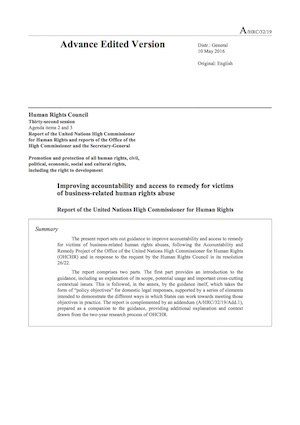This study reflects the findings of five on-the-ground pilot projects to examine what constitutes effective non-judicial grievance mechanisms. Its findings led to the eight principles of effectiveness for non-judicial grievance mechanisms, which are reflected in Guiding Principle 31 as the “effectiveness criteria.” The criteria are: legitimacy, accessibility, predictability, equitability, transparency, rights-compatibility, dialogue and engagement, continuous learning.
The summary below is excerpted from the resource.
Summary
This report sets out key lessons learned from a pilot project conducted in 2009-2010 to test the practical applicability of a set of principles for effective non-judicial grievance mechanisms that address complaints or disputes involving businesses and their stakeholders. The principles were developed by the Special Representative of the Secretary-General on the issue of human rights and transnational corporations and other business enterprises and set out in his reports to the Human Rights Council in 2008 (A/HRC/8/5) and 2009 (A/HRC/11/13).
The project was conducted on behalf of the Special Representative to help refine these principles in advance of their incorporation into a wider set of Guiding principles on business and human rights (A/HRC/17/31), which the Special Representative will present to the Human Rights Council in June 2011. The project focused on operational-level grievance mechanisms – that is, mechanisms developed by companies with/for stakeholders affected by their operations. The companies involved in the four main pilots to design or revise grievance mechanisms in line with the Special Representative’s principles were Carbones del Cerrejón, a coal mine in Colombia; Esquel Group, a Hong Kong-based garment company, working with its wholly-owned supplier in Viet Nam; Sakhalin Energy Investment Corporation, an oil and gas company in the Russian Federation; and Tesco Stores Ltd, a United Kingdom-based multinational supermarket chain, working with suppliers in South Africa. An adjunct project with Hewlett-Packard and two of its suppliers in China retrospectively analyzed their collaborative efforts to enhance suppliers’ grievance mechanisms and reviewed them in light of the Special Representative’s principles.
The purpose of the pilot project was to test the benefits of grievance mechanisms that are aligned with the Special Representative’s principles, and to learn lessons about how the principles could be further refined to reflect operational realities and enable their practical application. The extensive time spent in the process of designing or revising the grievance mechanisms meant that there was little time to monitor their operation in practice. Any such review will require further work in future. However, substantial lessons were gained from the processes undertaken. Those that are of most general relevance are summarized in this overarching report, while more specific and detailed learning is reflected in the individual reports of each project, which are attached in Annexes A to E.
- Section I of this report expands on the background and purpose of the project, defines what is meant by “operational-level grievance mechanisms,” and sets out the principles that were tested.
- Section II describes the methodology for the four main pilots (the separate methodology of the adjunct project is described in that specific report at Annex E).
- Section III reflects cross-cutting lessons learned, setting them out under each principle in turn, and concluding with an explanation of how the principle was adjusted to reflect the learning (adjustments were limited to the extent that they had to be applicable, not only to operational-level mechanisms, but also to other kinds of non-judicial mechanisms covered by the principles).
- Section IV offers a brief conclusion, and sets out the principles as revised.



